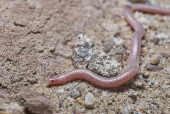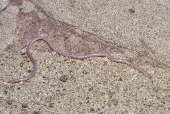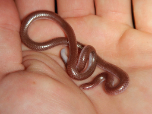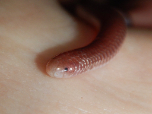 |
Western Blind Snake Range Map
|
|
|
 |
 |
 |
 |
 |
 |
 |
Western Blind Snake Video
|
|
|
 |
 |
 |
 |
 |
 |
 |
Western Blind Snake Juvenile
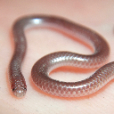
|
|
|
 |
 |
 |
 |
 |
 |
|
Western Blind Snake (Rena humilis)
Description: Rena humilis, like most species in the family Leptotyphlopidae, resembles a long earthworm. It lives underground in burrows, and since it has no use for vision, its eyes are mostly vestigial. The western blind snake is pink, purple, or silvery-brown in color, shiny, wormlike, cylindrical, blunt at both ends, and has light-detecting black eyespots. The skull is thick to permit burrowing, and it has a spine at the end of its tail that it uses for leverage. It is usually less than 12 inches in total length (tail included), and is as thin as an earthworm. This species and other blind snakes are fluorescent under low frequency ultraviolet light (black light). On the top of the head, between the ocular scales, R. humilis has only one scale (R. dulcis has three scales).
Habitat: Rena humilis lives underground, sometimes as deep as 66 feet, and is known to invade ant and termite nests.
Range: R. humilis is found in the southwestern United States and northern Mexico. In the US it ranges from southwestern and Trans-Pecos Texas west through southern and central Arizona, southern Nevada, southwestern Utah, and southern California. In Mexico its distribution includes the Mexican states of Baja California, Sonora, Sinaloa, Nayarit, Jalisco, Colima, Chihuahua, Durango, Coahuila, Tamaulipas, and San Luis Potosí.
Found in these States:
AZ |
CA |
NV
Diet: Its diet is made up mostly of insects and their larvae and eggs. It is found in deserts and scrub where the soil is loose enough to work.
Reproduction: Western blind snakes mate in the spring, and in the summer the females lay between two and six eggs underground. Blind snakes may lay their eggs in a communal nursery. They are only 0.625 inches long, and their mother guards them until they hatch. The hatchlings are only 3.5 inches long.
Status: Listed as Least Concern in view of its wide distribution, presumed large population, and because it is unlikely to be declining fast enough to qualify for listing in a more threatened category.
»» Kingdom: Animalia - Animals
»» Phylum: Chordata - Chordates
»» Subphylum: Vertebrata - Vertebrates
»» Class: Reptilia - Reptiles
»» Order: Squamata - Scaled Reptiles
»» Suborder: Serpentes
»» Infraorder: Scolecophidia
»» Family: Leptotyphlopidae - Blind Snakes
»» Genus: Rena
»» Species: Rena humilis - Western Blind Snake
»» Subspecies:
»» Rena humilis cahuilae - Desert Blind Snake
»» Rena humilis humilis - Southwestern Blind Snake
»» Rena humilis utahensis - Utah Blind Snake/Threadsnake
This article uses material from the Wikipedia article "Rena humilis", which is released under the Creative Commons Attribution-Share-Alike License 3.0. Content may have been omitted from the original, but no content has been changed or extended.
|
|




